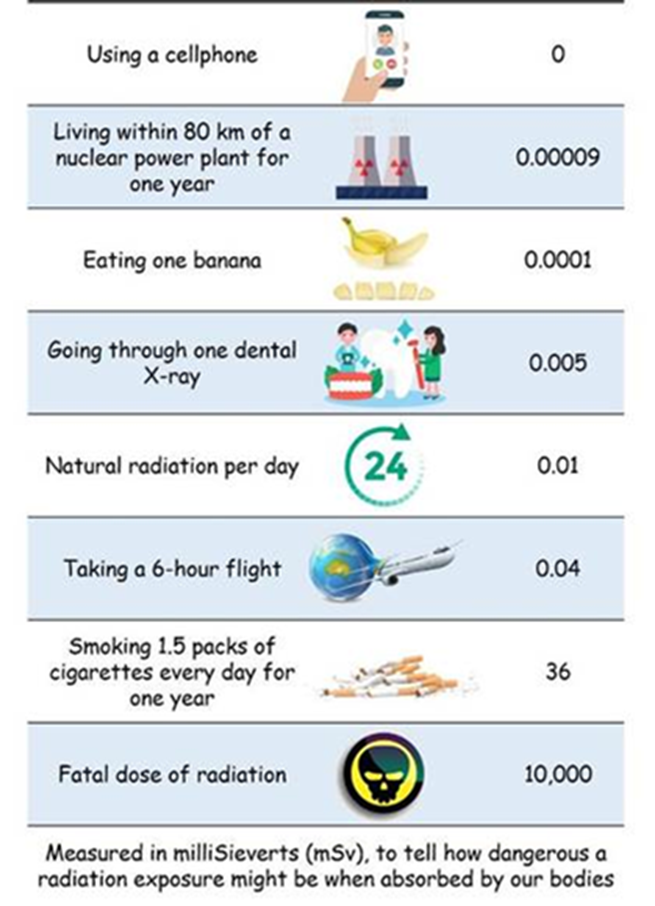Radiation in Foods? Friend or Foul ?
- Alpha Ho
- 3 min read
Fields covered: Radiation, Nuclear Physics, Microbiology, Food Science & Technology
Related Articles:
§ ![]() Food Irradiation: A Public Health Challenge for the 21st Century | §
Food Irradiation: A Public Health Challenge for the 21st Century | § ![]() Understanding Gamma Sterilisation | §
Understanding Gamma Sterilisation | § ![]() Journal of Hygienic Engineering and Design
Journal of Hygienic Engineering and Design
Do you know what makes our foods safe to eat? Chances are, radiation did not make it on your list.
Radiation in our daily lives
Radiation is defined as the energy carried by waves or particles and is often associated with grave consequences of increased risk of DNA mutations leading to cancer. As a matter of fact, we are constantly exposed to radiation[1]. Figure 1 spells out some sources of radiation and how much we are exposed to. Thankfully, the radiation that we are exposed to is nowhere near the lethal dosage.
Radiation for food preservation
How does radiation help make our food safe for consumption? A special technique called irradiation uses gamma radiation to preserve food products by reducing or eliminating microbes present. Gamma radiation is preferred due to its high penetration power as shown in Figure 2. A high dosage of food irradiation can kill pathogenic microbes (which can make you ill when you consume them) – this is known as Gamma sterilization[3].

Gamma sterilization kills microbes by interfering with their essential biological processes[3]. Overall, irradiating food extends its shelf life by reducing the likelihood of spoilage and eliminating the presence of pathogen microbes.
Irradiation is touted to be a controversial preservation technique since it uses ionizing radiation. Animal studies have shown that consuming irradiated foods impaired the growth of young rats and their organs contained high amounts of radioactivity. It is also shown that gamma irradiation can induce chemical reactions with unsaturated fats or nitrates in foods to produce carcinogens, which can lead to cancer.

Nevertheless, there is also a possibility that irradiated foods can be recontaminated by poor hygiene.
A common misconception is that irradiated foods are radioactive. Some believe that foods are safe when they are not treated with irradiation and become unsafe once they are exposed to gamma radiation. This could be attributed to the preconceived notion that radiation is detrimental to our health, and incomplete information about the propagation of radiation, resulting in fear of radiation in food. However, irradiation does not make our foods radioactive. It makes our food safe for consumption by killing off germs. Increasing awareness about the benefits of irradiation can create a more positive perception of using gamma rays to preserve our foods[5].
What do you think? What are your perspectives on using radiation in foods?
References
- SFA | Radiation and Food Safety. https://www.sfa.gov.sg/food-information/risk-at-a-glance/radiation-and-food-safety (accessed 2022-06-05).
- Acheson, D.; Steele, J. H. Food Irradiation: A Public Health Challenge for the 21st Century. Clinical Infectious Diseases 2001, 33 (3), 376–377. https://doi.org/10.1086/321899.
- Martin, J. M. Understanding Gamma Sterilization. BioPharm International 2012, 25 (2).
- Spiller, J. Radiant Cuisine: The Commercial Fate of Food Irradiation in the United States. Technology and Culture 2004, 45 (4), 740–763.
- Jankuloski, Z.; Marija B., Hristina S., and Ivana S. “Assessment of Public Opinion towards Irradiated Food.” Journal of Hygienic Engineering and Design 2022, 38, 93–101.




